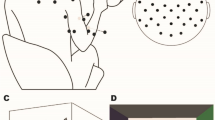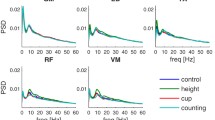Abstract
Coherence between electromyographic (EMG) signals has been used to identify correlated neural inputs to motor units (MUs) innervating different muscles. Simulations using a motor-unit model (Fuglevand et al. 1992) were performed to determine the ability of coherence between two multi-unit EMGs (mEMG) to detect correlated MU activity and the range of correlation strengths in which mEMG coherence can be usefully employed. Coherence between motor-unit and mEMG activities in two muscles was determined as we varied the strength of a 30-Hz periodic common input, the number of correlated MU pairs and variability of MU discharge relative to the common input. Pooled and mEMG coherence amplitudes positively and negatively accelerated, respectively, toward the strongest and most widespread correlating inputs. Furthermore, the relation between pooled and mEMG coherence was also nonlinear and was essentially the same whether correlation strength varied by changing common input strength or its distribution. However, the most important finding is that while the mEMG coherence saturates at the strongest common input strengths, this occurs at common input strengths greater than found in most physiological studies. Thus, we conclude that mEMG coherence would be a useful measure in many experimental conditions and our simulation results suggest further guidelines for using and interpreting coherence between mEMG signals.






Similar content being viewed by others
References
Amjad AM, Halliday DM, Rosenberg JR, Conway BA (1997) An extended difference of coherence test for comparing and combining several independent coherence estimates: theory and application to the study of motor units and physiological tremor. J Neurosci Methods 73:69–79
Ashby P, Zilm D (1982) Relationship between EPSP shape and cross-correlation profile explored by computer simulation for studies on human motoneurons. Exp Brain Res 47:33–40
Baker SN, Kilner JM, Pinches EM, Lemon RN (1999) The role of synchrony and oscillations in the motor output. Exp Brain Res 128:109–117
Binder MD, Powers RK (2001) Relationship between simulated common synaptic input and discharge synchrony in cat spinal motoneurons. J Neurophysiol 86:2266–2275
Christakos CN (1994) Analysis of synchrony (correlations) in neural populations by means of unit-to-aggregate coherence computation. Neurosci 58:43–57
Christakos CN (1997) On the detection and measurement of synchrony in neural populations by coherence analysis. J Neurophysiol 78:3453–3459
Christakos CN, Rost I, Windhorst U (1984) The use of frequency domain techniques in the study of signal transmission in skeletal muscle. Pflugers Archiv-European J Physiol 400:100–105
Conway BA, Halliday DM, Farmer SF, Shahani U, Maas P, Weir AI, Rosenberg JR (1995) Synchronization between motor cortex and spinal motoneuronal pool during the performance of a maintained motor task in man. J Physiol (Lond) 489:917–924
Cope TC, Fetz EE, Matsumura M (1987) Cross-correlation assessment of synaptic strength of single Ia fibre connections with triceps surae motoneurones in cats. J Physiol (Lond) 390:161–188
Day SJ, Hulliger M (2001) Experimental simulation of cat electromyogram: evidence for algebraic summation of motor-unit action-potential trains. J Neurophysiol 86(5):2144–2158
Farina D, Merletti R, Enoka RM (2004) The extraction of neural strategies from the surface EMG. J Appl Physiol 96(4):1486–1495
Farmer SF, Bremner FD, Halliday DM, Rosenberg JR, Stephens JA (1993) The frequency content of common synaptic inputs to motoneurones studied during voluntary isometric contraction in man. J Physiol 470:127–155
Farmer SF, Gibbs J, Halliday DM, Harrison LM, James LM, Mayston MJ, Stephens JA (2007) Changes in EMG coherence between long and short thumb abductor muscles during human development. J Physiol 579(2):389–402
Fetz EE, Gustafsson B (1983) Relation between shapes of post-synaptic potentials and changes in firing probability of cat motoneurones. J Physiol (Lond) 341:387–410
Fuglevand AJ, Winter DA, Patla AE, Stashuk D (1992) Detection of motor unit action potentials with surface electrodes: influence of electrode size and spacing. Biol Cybern 67:143–153
Fuglevand AJ, Winter DA, Patla AE (1993) Models of recruitment and rate coding organization in motor-unit pools. J Neurophysiol 70:2470–2488
Hansen S, Hansen NL, Christensen LO, Petersen NT, Nielsen JB (2002) Coupling of antagonistic ankle muscles during co-contraction in humans. Exp Brain Res 146(3):282–292
Johnston JA, Winges SA, Santello M (2005) Periodic modulation of motor-unit activity in extrinsic hand muscles during multidigit grasping. J Neurophysiol 94:206–218
Johnston JA, Winges SA, Santello M (2009) Neural control of hand muscles during prehension. In: Sternad D (ed) Progress in motor control—a multidisciplinary perspective. Springer, New York, pp 577–596
Keenan KG, Farina D, Maluf KS, Merletti R, Enoka RM (2005) Influence of amplitude cancellation on the simulated surface electromyogram. J Appl Physiol 98(1):120–131
Keenan KG, Farina D, Merletti R, Enoka RM (2006) Influence of motor unit properties on the size of the simulated evoked surface EMG potential. Exp Brain Res 169(1):37–49
Keenan KG, Farina D, Meyer FG, Merletti R, Enoka RM (2007) Sensitivity of the cross-correlation between simulated surface EMGs for two muscles to detect motor unit synchronization. J Appl Physiol 102(3):1193–1201
Kilner JM, Baker SN, Salenius S, Jousmaki V, Hari R, Lemon RN (1999) Task-dependent modulation of 15–30 Hz coherence between rectified EMGs from human hand and forearm muscles. J Physiol 516(2):559–570
Kilner JM, Alonso-Alonso M, Fisher R, Lemon RN (2002) Modulation of synchrony between single motor units during precision grip tasks in humans. J Physiol 541:937–948
Kirkwood PA, Sears TA (1978) The synaptic connexions to intercostal motoneurones as revealed by the average common excitation potential. J Physiol (Lond) 275:103–134
Kirkwood PA, Sears TA (1982) The effects of single afferent impulses on the probability of firing of external intercostal motoneurones in the cat. J Physiol (Lond) 322:315–336
Kirkwood PA, Sears TA, Tuck DL, Westgaard RH (1982) Variations in the time course of the synchronization of intercostal motoneurones in the cat. J Physiol 327:105–135
Knox CK (1974) Cross-correlation functions for a neuronal model. Biophys J 14:567–582
Lowery MM, Erim Z (2005) A simulation study to examine the effect of common motoneuron inputs on correlated patterns of motor unit discharge. J Comput Neurosci 19:107–124
Lowery MM, Myers LJ, Erim Z (2007) Coherence between motor unit discharges in response to shared neural inputs. J Neurosci Methods 163:384–391
Matthews PB (1996) Relationship of firing intervals of human motor units to the trajectory of post-spike after-hyperpolarization and synaptic noise. J Physiol (Lond) 492:597–628
McIsaac TL, Fuglevand AJ (2008) Common synaptic input across motor nuclei supplying intrinsic muscles involved in the precision grip. Exp Brain Res 188(1):159–164
Moore GP, Segundo JP, Perkel DH, Levitan H (1970) Statistical signs of synaptic interaction in neurons. Biophys J 10:876–900
Myers LJ, Lowery M, O’Malley M, Vaughan CL, Heneghan C, St Clair Gibson A, Harley YX, Sreenivasan R (2003) Rectification and non-linear pre-processing of EMG signals for cortico-muscular analysis. J Neurosci Methods 124(2):157–165
Neto OP, Christou EA (2010) Rectification of EMG signal impairs the identification of oscillatory input to the muscle. J Neurophysiol 103:1093–1103
Reyes AD, Fetz EE (1993a) Two modes of interspike interval shortening by brief transient depolarizations in cat neocortical neurons. J Neurophysiol 69:1661–1672
Reyes AD, Fetz EE (1993b) Two modes of interspike interval shortening by brief transient depolarizations in cat neocortical neurons. J Neurophysiol 69(5):1661–1672
Rosenberg JR, Amjad AM, Breeze P, Brillinger DR, Halliday DM (1989) The fourier approach to the identification of function coupling between neuronal spike trains. Prog Biophys Molec Biol 53:1–31
Santello M, Fuglevand AJ (2004) Role of across-muscle motor unit synchrony for the coordination of forces. Exp Brain Res 159:501–508
Santello M, Formicone G, Johnston JA, Hamm TH (2005) Assessment of across-muscle coherence using multi- vs. single-unit signals. Soc Neurosci Abstr 399.3
Sears TA, Stagg D (1976) Short-term synchronization of intercostal motoneurone activity. J Physiol (Lond) 263:357–381
Semmler JG, Kornatz KW, Dinenno DV, Zhou S, Enoka RM (2002) Motor unit synchronization is enhanced during slow lengthening contractions of a hand muscle. J Physiol 545:681–695
Semmler JG, Kornatz KW, Enoka RM (2003) Motor-unit coherence during isometric contractions is greater in a hand muscle of older adults. J Neurophysiol 90(2):1346–1349
Semmler JG, Sale MV, Meyer FG, Nordstrom MA (2004) Motor-Unit Coherence and its relation with synchrony are influenced by training. J Neurophysiol 92(6):3320–3331
Taylor AM, Enoka RM (2004a) Quantification of the factors that influence discharge correlation in model motor neurons. J Neurophysiol 91:796–814
Taylor AM, Enoka RM (2004b) Optimization of input patterns and neuronal properties to evoke motor neuron synchronization. J Comput Neurosci 16:139–157
Winges SA, Santello M (2004) Common input to motor units of digit flexors during multi-digit grasping. J Neurophysiol 92:3210–3220
Winges SA, Johnston JA, Santello M (2006) Muscle-pair specific distribution and grip type modulation of neural common input to extrinsic digit flexors. J Neurophysiol 96:1258–1266
Winges SA, Kornatz KW, Santello M (2008) Common input to motor units of intrinsic and extrinsic hand muscles during two-digit object hold. J Neurophysiol 99(3):1119–1126
Yao W, Fuglevand AJ, Enoka RM (2000) Motor-unit synchronization increases EMG amplitude and decreases force steadiness of simulated contractions. J Neurophysiol 83:441–452
Yao B, Salenius S, Yue GH, Brown RW, Liu JZ (2007) Effects of surface EMG rectification on power and coherence analyses: an EEG and MEG study. J Neurosci Methods 159(2):215–223
Acknowledgments
The authors would like to thank Dr. Andrew Fuglevand for consulting on the motor-unit simulation procedures. This work was partially supported by NIH grants R01 AR47301-01A2 (MS) and R01 NS22454-20 (TMH).
Author information
Authors and Affiliations
Corresponding author
Rights and permissions
About this article
Cite this article
Johnston, J.A., Formicone, G., Hamm, T.M. et al. Assessment of across-muscle coherence using multi-unit vs. single-unit recordings. Exp Brain Res 207, 269–282 (2010). https://doi.org/10.1007/s00221-010-2455-4
Received:
Accepted:
Published:
Issue Date:
DOI: https://doi.org/10.1007/s00221-010-2455-4




